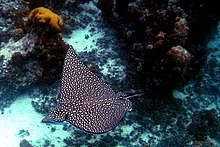Myliobatidae
| Eagle ray Temporal range: 100.5–0 Ma Late Cretaceous to Recent |
|
|---|---|
 |
|
| Spotted eagle ray, Aetobatus narinari | |
| Scientific classification | |
| Kingdom: | Animalia |
| Phylum: | Chordata |
| Class: | Chondrichthyes |
| Order: | Myliobatiformes |
| Family: |
Myliobatidae Bonaparte, 1838 |
The eagle rays are a group of cartilaginous fishes in the family Myliobatidae, consisting mostly of large species living in the open ocean rather than on the sea bottom.
Eagle rays feed on mollusks and crustaceans, crushing their shells with their flattened teeth. Devil and manta rays filter plankton from the water. They are excellent swimmers and are able to breach the water up to several metres above the surface. Compared with other rays, they have long tails, and well-defined rhomboidal bodies. They are ovoviviparous, giving birth to up to six young at a time. They range from 0.48 to 9.1 m (1.6 to 29.9 ft) in length.
Nelson's 2006 Fishes of the World (4th edition), as well as FishBase, recognizes seven genera in three subfamilies. Some systematists, such as William Toby White, raise the subfamilies to family level instead, placing the cownose rays in Rhinopteridae, and the manta and mobulas in Mobulidae. Under this arrangement, three genera (Aetobatus, Aetomylaeus and Myliobatis) remain in Myliobatidae, while a fourth (Pteromylaeus) is considered synomous with Aetomylaeus.
The spotted eagle ray, A. narinari, also known as the bonnet ray or maylan, belongs to this genus. The ray bears numerous white spots on its inky blue body. It has a span width of 2.5 m (8.2 ft) and a maximum reported weight of 230 kg (510 lb). Including the tail, it can reach up to 5 m (16 ft) in length. The spotted eagle ray is found in the tropical areas of all oceans, including the Caribbean Sea and the Gulf of Mexico. The genus also includes the much smaller longheaded eagle ray, A. flagellum, which is a widespread but uncommon species of Indian Ocean and western Pacific coasts. This is considered an endangered species due to huge pressure from fisheries throughout its range.
...
Wikipedia
